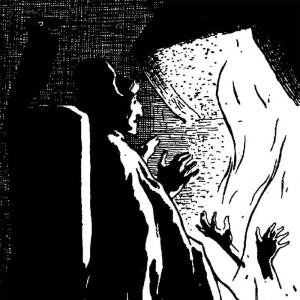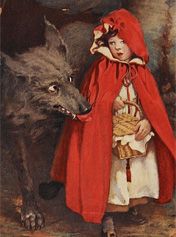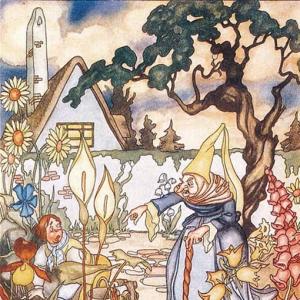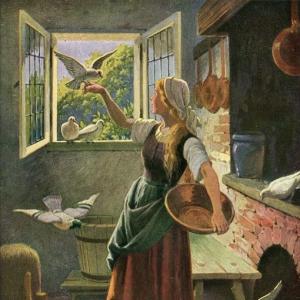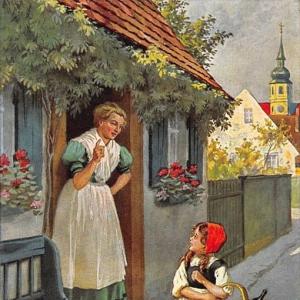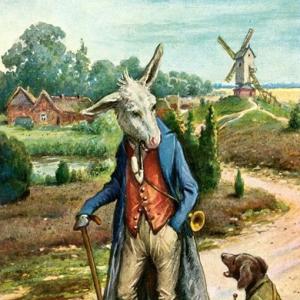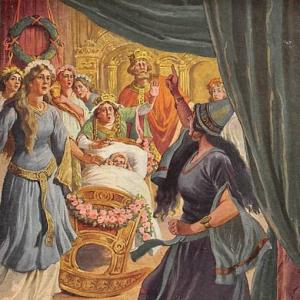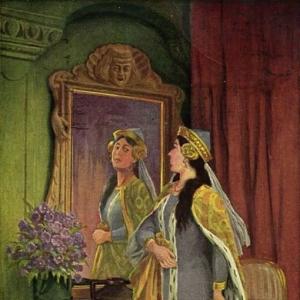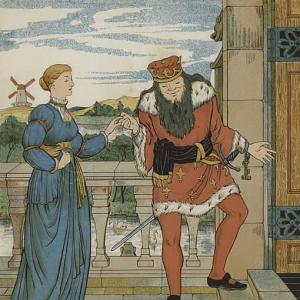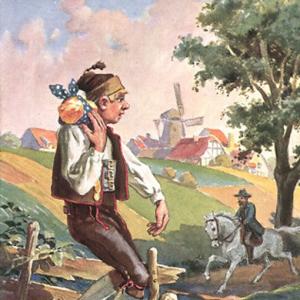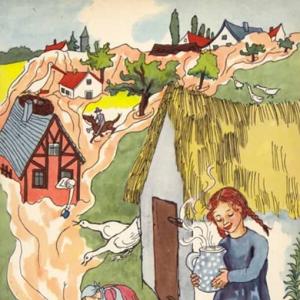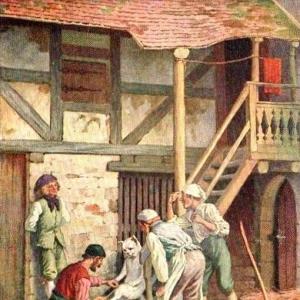Reading time for children: 7 min
Hans wished to put his son to learn a trade, so he went into the church and prayed to our Lord God to know which would be most advantageous for him. Then the clerk got behind the altar, and said, „Thieving, thieving.“ On this Hans goes back to his son, and tells him he is to learn thieving, and that the Lord God had said so. So he goes with his son to seek a man who is acquainted with thieving.
They walk a long time and come into a great forest, where stands a little house with an old woman in it. Hans says, „Do you know of a man who is acquainted with thieving?“ – „You can learn that here quite well,“ says the woman, „my son is a master of it.“ So he speaks with the son, and asks if he knows thieving really well? The master-thief says, „I will teach him well. Come back when a year is over, and then if you recognize your son, I will take no payment at all for teaching him; but if you don’t know him, you must give me two hundred thalers.“
The father goes home again, and the son learns witchcraft and thieving, thoroughly. When the year is out, the father is full of anxiety to know how he is to contrive to recognize his son. As he is thus going about in his trouble, he meets a little dwarf, who says, „Man, what ails you, that you are always in such trouble?“
„Oh,“ says Hans, „a year ago I placed my son with a master-thief who told me I was to come back when the year was out, and that if I then did not know my son when I saw him, I was to pay two hundred thalers; but if I did know him I was to pay nothing, and now I am afraid of not knowing him and can’t tell where I am to get the money.“ Then the dwarf tells him to take a small basket of bread with him, and to stand beneath the chimney. „There on the cross-beam is a basket, out of which a little bird is peeping, and that is your son.“
Hans goes thither, and throws a little basket full of black bread in front of the basket with the bird in it, and the little bird comes out, and looks up. „Hollo, my son, art thou here?“ says the father, and the son is delighted to see his father, but the master-thief says, „The devil must have prompted you, or how could you have known your son?“ – „Father, let us go,“ said the youth.
Then the father and son set out homeward. On the way a carriage comes driving by. Hereupon the son says to his father, „I will change myself into a large greyhound, and then you can earn a great deal of money by me.“ Then the gentleman calls from the carriage, „My man, will you sell your dog?“ – „Yes,“ says the father. „How much do you want for it?“ – „Thirty thalers.“ – „Eh, man, that is a great deal, but as it is such a very fine dog I will have it.“ The gentleman takes it into his carriage, but when they have driven a little farther the dog springs out of the carriage through the window, and goes back to his father, and is no longer a greyhound.
They go home together. Next day there is a fair in the neighboring town, so the youth says to his father, „I will now change myself into a beautiful horse, and you can sell me; but when you have sold me, you must take off my bridle, or I cannot become a man again.“ Then the father goes with the horse to the fair, and the master-thief comes and buys the horse for a hundred thalers, but the father forgets, and does not take off the bridle. So the man goes home with the horse, and puts it in the stable. When the maid crosses the threshold, the horse says, „Take off my bridle, take off my bridle.“ Then the maid stands still, and says, „What, canst thou speak?“
So she goes and takes the bridle off, and the horse becomes a sparrow, and flies out at the door, and the wizard becomes a sparrow also, and flies after him. Then they come together and cast lots, but the master loses, and betakes himself to the water and is a fish. Then the youth also becomes a fish, and they cast lots again, and the master loses. So the master changes himself into a cock, and the youth becomes a fox, and bites the master’s head off, and he died and has remained dead to this day.
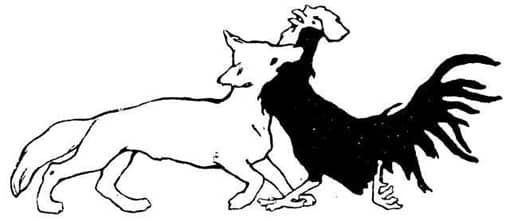
 Learn languages. Double-tap on a word.Learn languages in context with Childstories.org and Deepl.com.
Learn languages. Double-tap on a word.Learn languages in context with Childstories.org and Deepl.com.Backgrounds to fairy tale „The Thief and His Master“
„The Thief and His Master,“ also known as „Master and Pupil“ or „The Master Thief,“ is a lesser-known German fairy tale collected by the Brothers Grimm in their anthology „Grimms‘ Fairy Tales.“ The story follows the adventures of a young man who becomes an apprentice to a master thief, eventually outwitting his mentor and becoming a master himself.
The Brothers Grimm: Jacob and Wilhelm Grimm were German scholars, linguists, and cultural researchers who collected and published European folktales in the 19th century. Their goal was to preserve the rich oral tradition of storytelling found throughout Europe. Their collection, „Grimms‘ Fairy Tales,“ is considered one of the most influential works in the field of folklore. The original title of the story in German is „Der Meisterdieb,“ which translates to „The Master Thief.“ This tale is classified as Aarne-Thompson-Uther type 1525, a folktale classification system that organizes stories based on their similarities in narrative structure and motifs. The story type 1525 refers to tales that involve a thief and his apprentice or competitor.
Origins and influences: „The Thief and His Master“ is believed to have originated from the German oral tradition, passed down through generations of storytelling. The tale shares themes and motifs with other folktales and fairy tales, such as the importance of wit and cunning, the apprentice-master relationship, and the concept of using trickery to achieve success.
Structure and plot: The story follows a young man who is apprenticed to a master thief to learn the art of thievery. Throughout the tale, the master thief teaches his apprentice various tricks and skills. The apprentice, eager to surpass his master, eventually outwits him through cunning and deception, proving himself to be the superior thief. It is essential to remember that the Brothers Grimm collected and edited these stories from oral and written sources, which means that there are often multiple versions of each tale, each with regional or cultural variations. As such, „The Thief and His Master“ may have originated from various regions in Germany or Central Europe, reflecting local customs and beliefs.
Themes and motifs: „The Thief and His Master“ explores several themes and motifs common to many folktales and fairy tales: The story emphasizes the importance of intelligence, cunning, and quick thinking as the young apprentice learns from his master and eventually outsmarts him. The dynamic between the apprentice and his master is central to the story, highlighting the process of learning, growth, and eventual surpassing of the mentor. The use of deception and trickery is a key element in the tale, as the characters rely on their cunning to outwit one another and achieve their goals. „The Thief and His Master“ is one of many stories in the Grimm’s collection that involve magical transformation, trickery, and cunning. These themes are common in European folktales and fairy tales, and the Brothers Grimm often used them to explore moral lessons, human nature, and the battle between good and evil.
Morals and lessons: Although the story revolves around thievery, it imparts valuable life lessons about the importance of intelligence, resourcefulness, and adaptability. The tale also serves as a cautionary tale, warning readers about the potential consequences of greed and deceit.
In summary, „The Thief and His Master“ is a lesser-known Grimm’s fairy tale that focuses on the themes of wit, cunning, and the apprentice-master relationship. While the story centers on thievery, it also offers valuable lessons on the importance of intelligence and resourcefulness.
Interpretations to fairy tale „The Thief and His Master“
„The Thief and His Master“ by Brothers Grimm is a rich and intriguing story with various interpretations. Here are some key themes and interpretations to consider:
Divine guidance and predestination: The story begins with Hans seeking divine guidance from the Lord, which ultimately leads his son into learning thieving. This suggests that even unsavory skills and destinies may be predetermined and can challenge our understanding of morality.
Transformation and personal growth: The tale demonstrates the power of transformation and personal growth through the son’s ability to change his shape. He learns witchcraft and thieving from the master-thief, which allows him to outwit his opponents and escape unfavorable situations. This can be seen as a metaphor for the adaptability and resilience people can develop in the face of challenges.
Greed and deception: The story explores themes of greed and deception through the actions of the father, the son, and the master-thief. The son uses his thieving and shape-shifting skills to deceive others, while the master-thief attempts to deceive Hans by purchasing the transformed son. Hans‘ greed is evident when he sells his transformed son, forgetting the crucial step of removing the bridle. The story serves as a cautionary tale against greed and deception, as it ultimately leads to the master-thief’s demise. The story serves as a cautionary tale, warning readers about the potential consequences of greed and deceit. This interpretation suggests that while cunning and deception may lead to short-term gains, they can also have negative long-term consequences.
Cleverness and cunning: The son’s ability to outwit the master-thief, despite the latter’s expertise in deception, highlights the importance of cleverness and cunning. The son’s quick thinking and use of his newfound skills ultimately save him from the master-thief’s clutches and ensure his victory. The story highlights the value of intelligence, cunning, and quick thinking as the young apprentice learns from his master and eventually outsmarts him. This interpretation suggests that these qualities can lead to success and the ability to overcome challenges.
The apprentice-master relationship: The dynamic between the apprentice and his master plays a central role in the story, emphasizing the process of learning, growth, and eventually surpassing the mentor. This interpretation explores the concept of mentorship and the idea that students can sometimes surpass their teachers.
Trickery and deception: Deception and trickery are key elements in the tale, as the characters rely on their cunning to outwit one another and achieve their goals. This interpretation invites readers to consider the moral implications of using deception to attain success and the potential consequences of such actions.
Social commentary: The tale can also be interpreted as a critique of societal values, particularly the glorification of thievery and deceit. This interpretation invites readers to question the morals and ethics of the characters and the society in which they live. „The Thief and His Master“ presents a morally ambiguous narrative in which the main characters engage in thievery and deception. This interpretation encourages readers to ponder the complexity of morality and consider the circumstances in which certain actions may be deemed acceptable or justifiable.
Battle between good and evil: The story presents a struggle between good and evil, represented by the son and the master-thief, respectively. The son’s cleverness and cunning help him defeat the master-thief, which can be interpreted as a triumph of good over evil.
Overall, „The Thief and His Master“ offers a thought-provoking exploration of morality, personal growth, and the power of cunning and cleverness in overcoming challenges and defeating evil. In summary, „The Thief and His Master“ offers various interpretations, each providing a different perspective on the story’s themes and lessons. The tale’s multifaceted nature allows for a rich and engaging reading experience, inviting readers to reflect on its themes and connect them to their own lives.
Adaptions of the fairy tale „The Thief and His Master“
„The Thief and His Master“ is a popular fairy tale from the Brothers Grimm collection that has been adapted in various forms over the years. „The Thief and His Master“ is not as widely adapted as some other Brothers Grimm fairy tales. However, it has inspired some adaptations and works that draw on its themes and narrative. Here are a few examples:
Film adaptation: „The Thief and His Master“ was adapted into a German television film in 1988, titled „Der Meisterdieb“ (The Master Thief), directed by Walter Beck. This adaptation brings the story to life on screen, capturing the dynamics between the apprentice and the master and the theme of cunning and deception.
Animated films: The story has been adapted into several animated films, including „Dieb und Meister“ (1963) by Lotte Reiniger, „The Robber and His Master“ (1978) by Oleg Efremov, and „The Thief and the Cobbler“ (1993) by Richard Williams. While not as common as adaptations of more famous Grimm tales, „The Thief and His Master“ has been included in some animated series dedicated to the Brothers Grimm stories. For instance, „Simsala Grimm,“ a German animated series, features an episode based on „The Thief and His Master,“ which presents the story with a touch of humor.
Literature: Authors have occasionally incorporated elements of „The Thief and His Master“ into their own works, either as retellings or by drawing upon themes and motifs from the story. These literary works often explore the concepts of wit, cunning, and the apprentice-master relationship in new and imaginative ways. „The Thief and His Master“ has been adapted into several picture books for children, including „The Thief and the Innkeeper“ by Diane Stanley and „The Thief, the Fool, and the Big Fat King“ by Terry Deary.
Theater performance: Stage adaptations of „The Thief and His Master“ have been performed, often as part of larger productions of Grimm’s fairy tales. These performances use storytelling, music, and other theatrical techniques to bring the story to life for the audience, highlighting the themes of cunning, deception, and the dynamics between the apprentice and his master. The story has also been adapted for the stage, including a production by the New York City-based theater company, Ping Chong + Company, in which the characters are reimagined as immigrants in New York City.
Radio dramas: The story has been adapted into several radio dramas, including a production by the BBC in which the characters are reimagined as animals.
Art and illustrations: Various illustrators have created artwork for different editions of „Grimms‘ Fairy Tales“ or standalone books featuring „The Thief and His Master.“ These illustrations often capture key moments, characters, and themes of the story, adding a visual dimension to the narrative.
Although „The Thief and His Master“ may not have as many adaptations as some of the more popular Grimm tales, these examples demonstrate that the story continues to inspire artists and storytellers. The fairy tale’s themes of wit, cunning, and the apprentice-master relationship remain relevant and continue to resonate with audiences today. Overall, „The Thief and His Master“ has been adapted in various forms over the years, showcasing its enduring popularity and relevance to modern audiences. Its themes of mentorship, morality, loyalty, and family continue to resonate with people of all ages and backgrounds, making it a timeless tale that will continue to be retold for generations to come.
Abstract and Short summary
„The Thief and His Master“ is a fairy tale by the Brothers Grimm. The story begins with Hans, who seeks advice from the Lord about a trade for his son. When he receives the answer „thieving,“ he finds a master-thief to teach his son the trade. The master-thief agrees to teach the boy for a year, and if Hans recognizes his son afterward, there will be no fee. If not, he must pay two hundred thalers. The son learns thieving and witchcraft, and at the end of the year, Hans is worried about recognizing his son. A dwarf advises him to look for a basket with a bird inside, which turns out to be his son. The master-thief is surprised that Hans recognized the boy, and the father and son leave together.
On their way home, the son transforms into a greyhound and is sold to a gentleman for thirty thalers, but he escapes and returns to his father. At a fair, the son transforms into a horse, and Hans sells him to the master-thief for a hundred thalers. However, Hans forgets to remove the bridle, and the son remains a horse. At the master-thief’s home, a maid removes the bridle, and the son turns into a sparrow, with the master-thief transforming into one as well to chase him. The two sparrows cast lots, and the master-thief loses, transforming into a fish. The son follows suit, they cast lots again, and the master loses once more. The master becomes a cock, while the son transforms into a fox and kills him. The master remains dead, and the father and son continue their lives.
Summary of the plot
„The Thief and His Master,“ a fairy tale collected by the Brothers Grimm, tells the story of a young man who becomes an apprentice to a master thief, eventually outwitting his mentor and becoming a master himself. The story begins when a father, unable to afford his son’s education, apprentices him to a man who claims he can make the boy into a master thief. The master thief teaches the apprentice various tricks and skills, such as transforming himself into different animals and objects.
After some time, the master thief proposes a test for his apprentice to prove his skills. He challenges the boy to steal the parson’s horse and the sexton’s cow. The apprentice successfully completes the task by turning himself into a wolf, scaring the sexton up a tree, and taking the cow. He also tricks the parson into leaving his bed and steals the horse. The master thief then gives the apprentice a final task: stealing a count’s prized rooster. The apprentice disguises himself as a beggar and convinces the count to let him sleep in the castle. During the night, he steals the rooster, along with the count’s daughter and a guard.
Outwitted and impressed by his apprentice’s cunning, the master thief acknowledges the young man as his equal and allows him to go free. The apprentice eventually marries the count’s daughter and becomes a master thief himself, using his skills and cunning to outwit others. „The Thief and His Master“ emphasizes themes such as intelligence, cunning, and the apprentice-master relationship, as well as the idea of using deception to achieve success.
Informations for scientific analysis
Fairy tale statistics | Value |
|---|---|
| Number | KHM 68 |
| Aarne-Thompson-Uther-Index | ATU Typ 325 |
| Translations | DE, EN, DA, ES, PT, IT, JA, NL, PL, RU, TR, VI |
| Readability Index by Björnsson | 29.1 |
| Flesch-Reading-Ease Index | 84.1 |
| Flesch–Kincaid Grade-Level | 6.7 |
| Gunning Fog Index | 9.3 |
| Coleman–Liau Index | 6.5 |
| SMOG Index | 7.5 |
| Automated Readability Index | 6.7 |
| Character Count | 4.056 |
| Letter Count | 3.046 |
| Sentence Count | 39 |
| Word Count | 804 |
| Average Words per Sentence | 20,62 |
| Words with more than 6 letters | 68 |
| Percentage of long words | 8.5% |
| Number of Syllables | 968 |
| Average Syllables per Word | 1,20 |
| Words with three Syllables | 21 |
| Percentage Words with three Syllables | 2.6% |

